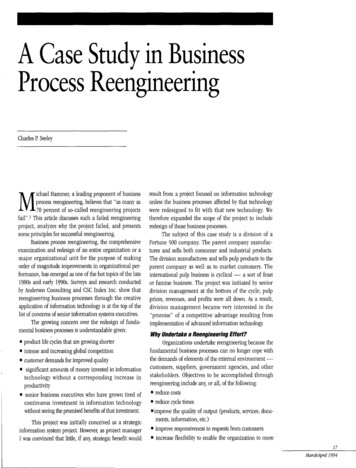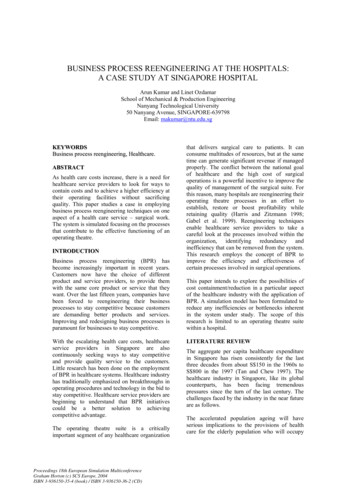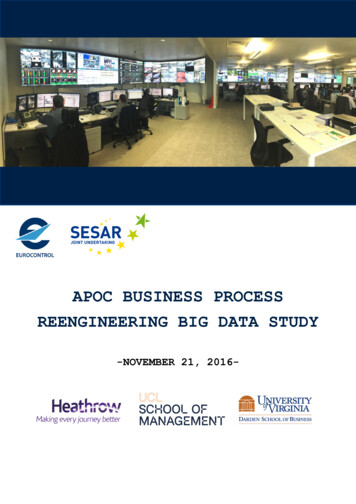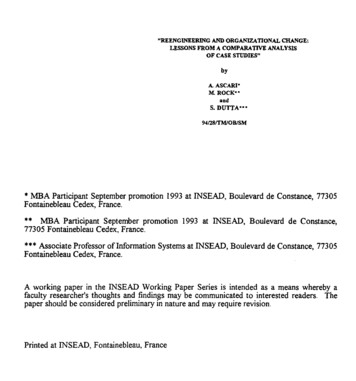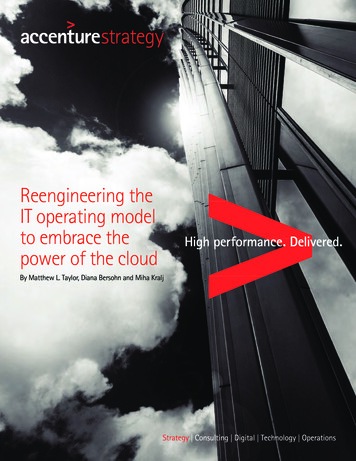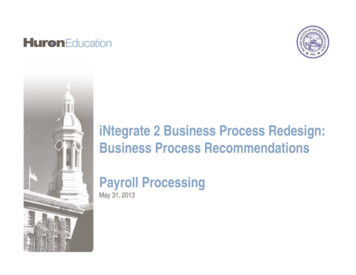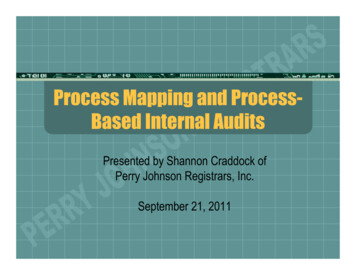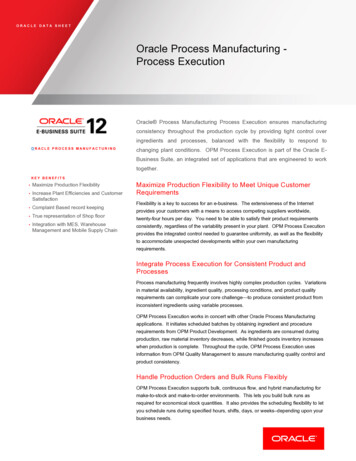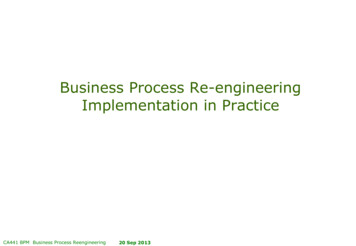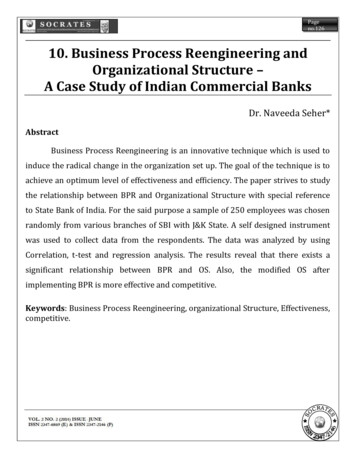
Transcription
Pageno.12610. Business Process Reengineering andOrganizational Structure –A Case Study of Indian Commercial BanksAbstractDr. Naveeda Seher*Business Process Reengineering is an innovative technique which is used toinduce the radical change in the organization set up. The goal of the technique is toachieve an optimum level of effectiveness and efficiency. The paper strives to studythe relationship between BPR and Organizational Structure with special referenceto State Bank of India. For the said purpose a sample of 250 employees was chosenrandomly from various branches of SBI with J&K State. A self designed instrumentwas used to collect data from the respondents. The data was analyzed by usingCorrelation, t-test and regression analysis. The results reveal that there exists asignificant relationship between BPR and OS. Also, the modified OS afterimplementing BPR is more effective and competitive.Keywords: Business Process Reengineering, organizational Structure, Effectiveness,competitive.
Full Text:Pageno.1271. IntroductionBusiness organizations throughout the world are experiencing a high level ofcompetition and uncertainty in all the affairs of business. As a result, most of theorganizations are desperately feeling the immediate and drastic need of change intheir structure, processes, strategies, people etc so, that they remain relevant in thehighly compact market. Banking industry is one of the highly competitive and fastestgrowing industries in India and all over the world as well. To upgrade the standardof their operations and the demands of market many banks throughout world and inIndia have implemented a contemporary transformation technique that is BusinessProcess Reengineering in their organizations. Business Process Reengineering(BPR) is a potent management tool to bring radical changes in business. BPR wasdiscovered by the Michael Hammer in 1990. Concept of Business ProcessReengineering (BPR): BPR is the fundamental rethinking and radical redesign ofbusiness processes to achieve dramatic improvements in critical contemporarymeasures of performance, such as cost, quality, services, and speed (Hammer &Champy, 1993). Reorganizing the company or according to its processesconsequently requires to rethink them. One needs a good sense of processes thatallows BPR through the following four steps (Frias, 2002): Getting back to thebasics: It is necessary to ask the fundamental question regarding the needs of thecompany, the essential information it should dispose, the fundamental relations foroptimized planning, taking into account different actors: All actors that areconcerned by the process reorganization have to be concentrated on, integration ofall hierarchical levels: In order to redesign processes, the managers but also the
Pageno.128lower level hierarchical levels have to be involved in the BPR effort, having thesense of responsibility: BPR is not only done for a better control of the companyprocesses but also to establish a structure to locate the diverse responsibilitieswithin the processes.Business process reengineering ideas are based on the premise that everyorganization needs a sense of direction. Without that direction in the form ofstrategic plans and business plans, the organization has no foundation upon whichto build process improvements. BPR is a method of improving the operation andtherefore the outputs of organizations. Generally the topic of BPR involvesdiscovering how business processes currently operate, how to redesign theseprocesses to eliminate the wasted or redundant effort, improve efficiency, and howto implement the process changes in order to gain competitiveness. The purpose ofBPR is to find new ways to organize tasks, organize people and use informationtechnology so that the processes support the organization’s goals. It meansanalyzing and altering the business processes of the organization as a whole. For athorough and effective reengineering project, organizations should first meetcertain conditions before starting such a project. Initially, the management shouldabandon all the rules and procedures that have been used up to that time. Inaddition they should abandon other inadequate organizational and productionprinciples. At this point, the design of a renovated and redesigned organizationshould begin. According to Hammer and Champy (1993), “Reengineering is thefundamental rethinking and radical redesign of business processes to achievedramatic improvements in critical, contemporary measures of performance, such ascost, quality, service and speed”. Vidgen (1994) defines the central key points of
Pageno.129BPR as:: radical change and assumption challenge, process and goal orientation,organizational restructuring, the exploitation of enabling technologies, particularlyinformation technology, Which means that by focusing on business objectives,processes are analyzed in the organization, non-essential or redundant proceduresare eliminated, and then IT is used to redesign and streamline organizationalprocesses. BPR is a radical change rather than an incremental change. Davenport(1993) advocates radical change as: Objectives of 5% or 10% improvement in allbusiness processes each year must give way to efforts to achieve 50%, 100%, oreven higher improvement levels in a few key processes. Radical change is the onlymeans of obtaining the order of magnitude improvements necessary in today’sglobal marketplace. Existing approaches to meeting customer needs are sofunctionally based that incremental change will never yield the requisiteinterdependence. These properties of Business Process Reengineering can befollowed to manage the crises which have usually following features. The situationmaterialises unexpectedly, decisions are required urgently, time is short, specificthreats are identified, urgent demands for information are received, there is sense ofloss of control, treasures build over time, routine business become increasinglydifficult, demands are made to identify someone to blame,ooutsiders’ take anunaccustomed interest, rreputation suffers, communications are increasinglydifficult to manage. BPR is a transformation technique which aims to revive theorganizations that are mal functioning due to change in external and internalenvironment. These crises may have their origin in processes, people, strategies,structure, and technology. These are exactly the areas over which BPR works andtries to remove the inefficiencies.
Pageno.130The paper gives a brief about the position of BPR model in different banksoperating in different regions. The study compares and analyses the position of BPRpractices in SBI and Jammu & Kashmir Bank. This study was based upon the nullhypothesis, “There exists no significant difference between BPR model in SBI andJammu rural banks”. The research objectives were, to understand the BPR model inSBI, to understand the BPR model in Jammu Rural Banks, to compare the BPR modelin SBI and Jammu Rural Banks, to suggest improvement measures for Jammu RuralBanks.1.1 Business Process Reengineering in the Back Drop of HistoryBusiness Process ReState of the Art, is theconstitution of setting the work and waste concept in each step in any process inany entity, that’s it as a Generic Concept. And the objective of process reis to eliminate the waste components/elements and try enriching the workcomponents/elements (Ragab, E.A., 2009). Value-creation for the customer is theleading factor for BPR and information technology often plays an importantenabling role. BPR benefits customers through significantly reduced transactiontime, flexibility in servicing and improved value chain of service (Sharma, M., 2006).Business process reengineering has become useful weapon for any corporateorganizations that is seeking for improvement in their current organizationalperformance and intends to achieve cost leadership strategy in its operatingindustry and environment. Reengineering process remains effective tools fororganizations striving to operate as effectively and efficiently as possible andorganizations are required to reengineer their business processes in order toachieve breakthrough performance and long term strategy for organizational
Pageno.131growth and performance (Adeyemi, et.al, 2008). Organizations achieve competitiveadvantage by implementing Business Process Reengineering (BPR). It was observedthat BPR makes organization more competitive by significantly modifying the costsincurred, customer services, quality and productivity. (Magutu, P.O et al, 2010). Reengineering of business processes directly affects the satisfaction level of customers.The researchers have supported that more use of IT, wide network of ATMS, ReSkilled staff, help nationalized banks to gain competitive advantage in the industry(Datta, S.K., Gupta, A., 2009). Business Process ReState of theArt, is the constitution of setting the work and waste concept in each step in anyprocess in any entity, that’s it as a Generic Concept. The researcher maintains thatincrease in work efficiency and decrease waste is the goal of BPR. (Ragab, E.A.,2009). Organizations may have to restructure their processes, only then they canreap up the benefits of new information technologies (Rock, N.L., 2003). BPR is amodern tool to manage the changes that happened due to IT revolution in businessworld. In order to survive in highly dynamic conditions, organizations have torestructure and redefine their business strategies. BPR helps in cost reduction whilespeed, quality and service are dramatically improved. There are greater chances ofBPR success if it is viewed as a tool leading to growth and value creation(Thyagarajan, V., Khatibi A., 2004). CRM should be reengineered even if it is inpractice since years. The researcher concludes that successful implementation ofBPR for CRM will result in reduced costs, shorter cycle time, improved quality andmost important happier customers (Pruit, C. 2009). There are certain criticalsuccess factors (CSFs) which are responsible for success or failure of a BPR project.Interpretive Structural Modeling (ISM) to indentify critical success factors. The
Pageno.132researchers have identified 9 CSFs through the use of ISM Approach along with theirrelative significance. (Salimifard, K., 2010).2. Overview of Indian Banking IndustryIndian banking industry has transformed in recent years due to globalization in theworld market, which has resulted in fierce competition. This new competitiveenvironment has resulted in new challenges for the banking industry to benchmarkwork culture on parameters which are globally standardized. The new generationbanks have infused intense competition into the industry requiring higherutilization of technology, improved customer service and innovative products. CoreBanking Solutions (CBS) now emphasizes on the technological applications whichwould facilitate the intergradations of all customer channels seamlessly. Branchesare becoming delivery channels and employees salesmen. Banks are going beyondconventional banking and offering a lot more than vanilla deposits and loans. Thus,there is a paradigm shift from the seller’s market to buyer’s market in the industryand finally it is affected at the bankers’ level to change their approach from“conventional banking to convenience banking” and “mass banking to classbanking”. This has resulted in increased the degree of accessibility of a common manto bank for catering to his or her variety of needs and requirements.This therefore has enfolded a new agenda for the banking organizations for honingof skills and capabilities which would enhance the core competencies of the humancapital for adapting to changed requirements and as well align corporate strategywith the market opportunities and challenges besides retaining employees. Newwork culture has significantly impacted the employees and as well as theorganizations, as such attention of the researchers, especially in last three decadeshas been to investigate organic relationship between culture and workeffectiveness. Despite the acknowledged importance of the quality of work culture,extensive research has yet to be carried out in the banking sector operating in thestate of Jammu and Kashmir.
2.1 Research HypothesesPageno.133H1: There exists positive relationship between Business Process ReengineeringPractices and Organizational Structure in the banks under study.3. Research Objectives1. To study the impact of Business Process Reengineering Practices onorganizational structure.2. To compare the effectiveness of BPR Process among the banks under study.4. Study AreaWith a view to achieve the objectives and test the hypothesis laid, the datahas been collected through both primary and secondary sources. Primary data wascollected through a structured questionnaire administered to the employees servingin the Jammu & Kashmir Bank and State Bank of India for analyzing work cultureexperiences and resultant performance effectiveness. The above mentioned bankswere purposively selected as they represented two biggest service organizations inJammu & Kashmir state. An attempt has been made to analyze work culture andservice efficiency and it impact on employee effectiveness among different strata’s.The technique of stratified sampling has been used to select the sampleemployees on the basis of the levels of manager’s i.e. top level, middle level andlower level managers. The present study has been undertaken on the bankingindustry in the state of Jammu and Kashmir. A sample of 100 employees was takenfor the study.
Pageno.1345. Analysis and FindingsThe data so collected was subjected to correlation analysis, regressionanalysis and independent t-test.5.1 Hypothesis TestingCorrelation Analysis was used to test the hypothesis the results of which areshown in the Table-5.1.1.Table-5.1.1, rrelat
10. Business Process Reengineering and Organizational Structure – A Case Study of Indian Commercial Banks Dr. Naveeda Seher* Abstract Business Process Reengineering is an innovative technique which is used to induce the radical change in the organization set up. The goal of the technique is to achieve an optimum level of effectiveness and efficiency. The paper strives to studyAuthor: Seher Dr. NaveedaPublish Year: 2014
